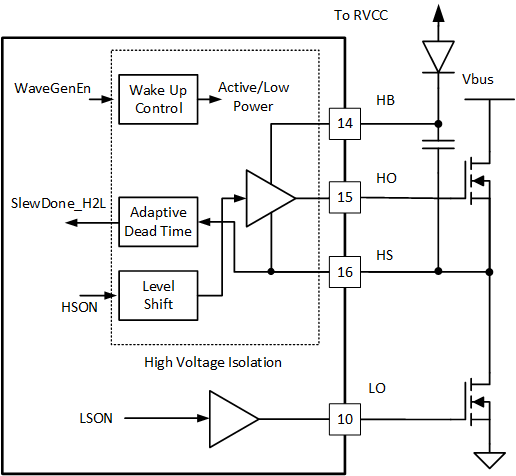SLUSD90E June 2019 – February 2021 UCC256402 , UCC256403 , UCC256404
PRODUCTION DATA
- 1 Features
- 2 Applications
- 3 Description
- 4 Revision History
- 5 Pin Configuration and Functions
- 6 Specifications
-
7 Detailed Description
- 7.1 Overview
- 7.2 Functional Block Diagram
- 7.3 Feature Description
- 7.4 Device Functional Modes
- 8 Power Supply Recommendations
- 9 Layout
- 10Device and Documentation Support
7.3.8 High Voltage Gate Driver
LO is the low-side gate driver output. The gate driver is supplied by the 13-V RVCC rail.
The high-side driver module consists of three physical device pins. HB and HS form the positive and negative bias rail, respectively, of the high-side driver, and HO connects to the gate of the upper half-bridge MOSFET.
During periods when the lower half-bridge MOSFET is conducting, HS is shorted to GND via the conducting lower MOSFET. At this time power for the high-side driver is obtained from RVCC via the high voltage diode DBOOT, and capacitor CBOOT is charged to RVCC minus the forward drop on the diode.
During periods when the upper half-bridge MOSFET is conducting, HS is connected to the LLC input voltage rail. At this time the HV diode is reverse biased and the high-side driver is powered by the charge stored in CBOOT.
Both the high-side and low-side gate drivers have under voltage lock out (UVLO) protection. The low-side gate driver UVLO is implemented on RVCC; the high-side gate driver UVLO is implemented on (HB - HS) voltage.
When operating at light load, UCC25640x enters burst mode. During the burst off period, the gate driver enters low power mode to reduce power consumption.
The block diagram of the gate driver is shown in Figure 7-10.
 Figure 7-10 Gate Driver Block Diagram
Figure 7-10 Gate Driver Block Diagram